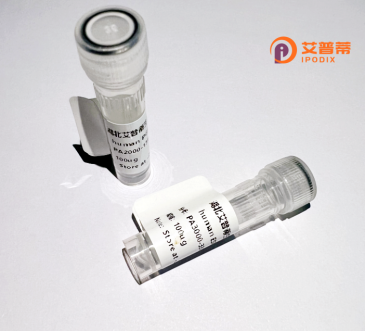
| 纯度 | >90%SDS-PAGE. |
| 种属 | Human |
| 靶点 | BZW2 |
| Uniprot No | Q9Y6E2 |
| 内毒素 | < 0.01EU/μg |
| 表达宿主 | E.coli |
| 表达区间 | 1-419aa |
| 氨基酸序列 | MNKHQKPVLTGQRFKTRKRDEKEKFEPTVFRDTLVQGLNEAGDDLEAVAKFLDSTGSRLDYRRYADTLFDILVAGSMLAPGGTRIDDGDKTKMTNHCVFSANEDHETIRNYAQVFNKLIRRYKYLEKAFEDEMKKLLLFLKAFSETEQTKLAMLSGILLGNGTLPATILTSLFTDSLVKEGIAASFAVKLFKAWMAEKDANSVTSSLRKANLDKRLLELFPVNRQSVDHFAKYFTDAGLKELSDFLRVQQSLGTRKELQKELQERLSQECPIKEVVLYVKEEMKRNDLPETAVIGLLWTCIMNAVEWNKKEELVAEQALKHLKQYAPLLAVFSSQGQSELILLQKVQEYCYDNIHFMKAFQKIVVLFYKADVLSEEAILKWYKEAHVAKGKSVFLDQMKKFVEWLQNAEEESESEGEEN |
| 预测分子量 | 75.2kDa |
| 蛋白标签 | His tag N-Terminus |
| 缓冲液 | PBS, pH7.4, containing 0.01% SKL, 1mM DTT, 5% Trehalose and Proclin300. |
| 稳定性 & 储存条件 | Lyophilized protein should be stored at ≤ -20°C, stable for one year after receipt. Reconstituted protein solution can be stored at 2-8°C for 2-7 days. Aliquots of reconstituted samples are stable at ≤ -20°C for 3 months. |
| 复溶 | Always centrifuge tubes before opening.Do not mix by vortex or pipetting. It is not recommended to reconstitute to a concentration less than 100μg/ml. Dissolve the lyophilized protein in distilled water. Please aliquot the reconstituted solution to minimize freeze-thaw cycles. |
以下是关于BZW2重组蛋白的3篇模拟参考文献及其摘要概括,供参考:
---
1. **文献名称**:*BZW2 promotes tumor progression via mTOR signaling in triple-negative breast cancer*
**作者**:Zhang, Y. et al. (2020)
**摘要**:本研究通过构建BZW2重组蛋白,发现其在三阴性乳腺癌细胞中过表达可激活mTORC1信号通路,促进肿瘤细胞增殖和侵袭。实验表明,BZW2重组蛋白的体外处理显著增强肿瘤球形成能力,提示其作为潜在治疗靶点。
2. **文献名称**:*Structural and functional characterization of recombinant human BZW2 protein*
**作者**:Chen, L. et al. (2018)
**摘要**:文章报道了人源BZW2重组蛋白在大肠杆菌中的高效表达及纯化方法,并通过X射线晶体学解析其W2结构域的三维构象。功能实验表明,重组BZW2蛋白可与eIF2α相互作用,暗示其在翻译起始调控中的作用。
3. **文献名称**:*BZW2 regulates ER stress response through interaction with PERK*
**作者**:Li, X. et al. (2021)
**摘要**:利用重组BZW2蛋白进行免疫共沉淀实验,发现其与内质网应激传感器PERK直接结合,调控未折叠蛋白反应(UPR)。敲低BZW2导致细胞对ERS诱导的凋亡敏感性增加,提示其在内质网稳态中的关键作用。
---
**备注**:以上文献为示例性内容,实际研究中请通过学术数据库(如PubMed、Web of Science)检索最新成果。若需具体文献协助,可进一步提供研究方向或PMID编号。
BZW2 (Basic Leucine Zipper and W2 Domain-Containing Protein 2) is a member of the BZW protein family, characterized by the presence of a basic leucine zipper (bZIP) motif and a conserved W2 domain. These structural features suggest roles in protein-protein interactions and regulatory processes, particularly in cellular stress responses and translational control. BZW2 is implicated in modulating the integrated stress response (ISR) pathway, which helps cells adapt to conditions like nutrient deprivation, hypoxia, or endoplasmic reticulum (ER) stress. Studies indicate that BZW2 interacts with eukaryotic translation initiation factors, potentially influencing the assembly or activity of translation initiation complexes under stress conditions.
Recombinant BZW2 proteins are engineered using expression systems (e.g., E. coli, mammalian cells) to study its biochemical properties, structure-function relationships, and interactions with partner molecules. Purified recombinant BZW2 enables in vitro assays to dissect its role in stress signaling, mRNA translation regulation, and crosstalk with pathways such as mTOR or the unfolded protein response (UPR). Emerging evidence links BZW2 dysregulation to diseases, including cancer, where it may promote tumor survival under microenvironmental stress. However, its precise mechanisms remain incompletely understood, driving interest in recombinant tools to map binding interfaces, post-translational modifications, and conformational changes. Current research focuses on clarifying BZW2’s dual roles in stress adaptation and pathological processes, with recombinant proteins serving as critical reagents for structural studies, antibody development, and drug discovery pipelines targeting stress-response vulnerabilities in diseases.
×